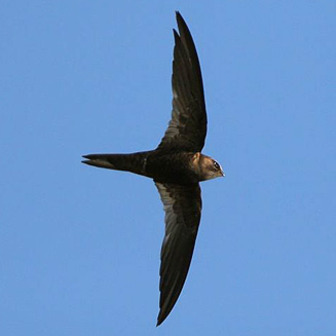African Black Swift
The nominate South African subspecies is migratory, wintering further north. Other subspecies are resident. Of the other seven accepted forms, the most widespread is the small dark A. b. roehli of east Africa. Two other dark races, A. b. balstoni and A. b. mayottensis, are restricted to Madagascar and the Comoro Islands respectively. It has been suggested that some balstoni migrate to the continental mainland when not breeding, but this has not been proved.

Original source: Trevor Hardaker, Cape Town, South AfricaPermission(Reusing this file)The permission for use of this work has been archived in the Wikimedia OTRS system.It is available here for users with an OTRS account. If you wish to reuse this work elsewhere, please read the instructions at COM:REUSE. If you are a Commons user and wish to confirm the permission, please leave a note at the OTRS noticeboard.Ticket link: https://secure.wikimedia.org/otrs/index.pl?Action=AgentTicketZoom&TicketID=2258283
Author: Trevor Hardaker, Cape Town, South AfricaPermission(Reusing this file)The permission for use of this work has been archived in the Wikimedia OTRS system.It is available here for users with an OTRS account. If you wish to reuse this work elsewhere, please read the instructions at COM:REUSE. If you are a Commons user and wish to confirm the permission, please leave a note at the OTRS noticeboard.Ticket link: https://secure.wikimedia.org/otrs/index.pl?Action=AgentTicketZoom&TicketID=2258283
The African Black Swift is classified as Least Concern. Does not qualify for a more at risk category. Widespread and abundant taxa are included in this category.
The African Swift or African Black Swift, Apus barbatus, is a small bird in the swift family. It breeds in Africa discontinuously from Liberia, Cameroon, Zaire, Uganda and Kenya south to South Africa, and on Madagascar. The breeding habitat is damp mountains, typically between 1,600 - 2,400 m, but less often at lower altitudes. This species feeds readily over lowland, and can form very large flocks, often with other gregarious swifts. More
African black swift, Milnerton Sewage Works, South Africa. African black swift, Luneberg, South Africa. Apus barbatus (African black swift, Black swift) African black swift, Milnerton Sewage Works, South Africa. The African black swift occurs in large areas of sub-Saharan Africa, with the bulk of its population in eastern as well as southern Africa. It feeds primarily on flying insects, often hunting in mixed species flocks, especially during termite alate emergences. More
African Black Swift pair together at nesting site - Adults on nest Photographer More
Whilst I have little experience of African Black Swift in other parts of its range, I hope the text that follows will be of interest. - The "Luandan Black Swifts" had a distinctive flight action which consisted of a fairly steady level flight broken with short glides. - They appeared to be in pairs - or at least were interacting in a way that suggested that they were paired-up or courting. More
African black swift kruger national park birds The African Black Swift (Latin name Apus barbatus) is described in Roberts Birds of Southern Africa, 7th Edition. This bird has a unique Roberts number of 412 and you will find a full description of this bird on page 238 also a picture of the African Black Swift on page 257. The African Black Swift belongs to the family of birds classified as apodidae. More
African Black Swift, African Swift, Madagascar Swift Common Names in German: Kapsegler Common Names in Japanese: ミナミクロアマツバメ Taxonomy - * Domain: Eukaryota () - Whittaker & Margulis,1978 - eukaryotes * Kingdom: Animalia () - Linnaeus, 1758 - animals More
